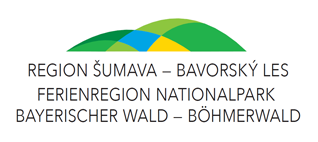4 – Kašperk Castle
Kašperk Castle during the era of the Golden Trail and the Golden Road
The founding of the Kašperk Castle is directly related to these important medieval routes. The order to build it was given by the Bohemian King and Holy Roman Emperor Charles IV in 1356. It was meant to be a border guarding castle, which would protect Šumava and its surrounding areas, as well as the gold-mining region of Kašperské Hory, including upper Šumava. The castle guards were also to guard the two then-new trade route, the Golden Road and the Golden Trail. They both led from Kašperské Hory to Passau, one through the land of the Passau bishopric and the other through a Bavarian duchy.
Another reason for its construction was the need to uphold and support the royal administration in Southwest Bohemia. As such, Kašperk was home to the most prominent royal court officials. This is probably why representative halls and chambers were built, so that the officials may reside here with their families. Up until 1409 the holder of the castle had the role of the arbiter of the law.
The Kašperk Castle and its holders had an existential stake in the prosperity of the commerce on the Golden Road and the Golden Trail, as the customs and tolls brought them no small profits.
The founding of the Kašperk Castle is directly related to these important medieval routes. The order to build it was given by the Bohemian King and Holy Roman Emperor Charles IV in 1356. It was meant to be a border guarding castle, which would protect Šumava and its surrounding areas, as well as the gold-mining region of Kašperské Hory, including upper Šumava. The castle guards were also to guard the two then-new trade route, the Golden Road and the Golden Trail. They both led from Kašperské Hory to Passau, one through the land of the Passau bishopric and the other through a Bavarian duchy.
Another reason for its construction was the need to uphold and support the royal administration in Southwest Bohemia. As such, Kašperk was home to the most prominent royal court officials. This is probably why representative halls and chambers were built, so that the officials may reside here with their families. Up until 1409 the holder of the castle had the role of the arbiter of the law.
The Kašperk Castle and its holders had an existential stake in the prosperity of the commerce on the Golden Road and the Golden Trail, as the customs and tolls brought them no small profits.
Area, nature, personalities, events
Kašperk Castle, situated 886 m. a. s. l., is our highest situated royal castle. It is almost completely built from a rock called leptynite, which can be found only on the castle and in its surroundings. Today, Kašperk lies in the beautiful environment of the Kašperk Highlands natural park and its towers offer unique views upon Šumava and surrounding landscape.
Close to the castle itself, on the foot of the Castle hill, can be found the remains of the front battlements. The so-called Pustý hrádek (Desolate castle), which stands in the forest right of the castle, offers, apart from a beautiful view of Šumava, an exquisite view of the Kašperk castle itself.
The first pledge holder of the castle after Charles IV´s death became the Empire ally of our House of Luxemburg, John of Leuchtenberg in 1379. Still during Charles IV´s life, Leuchtenberg built the de facto competition to the Kašperské Hory Golden Trail, the so-called Golden Road. He pointed this communication towards Passau over the land of the Bavarian duchy. He himself initiated with Charles IV the process of elevating Hals and Grafenau into town statuses and included them in trade with Bohemia.
Kašperk Castle, situated 886 m. a. s. l., is our highest situated royal castle. It is almost completely built from a rock called leptynite, which can be found only on the castle and in its surroundings. Today, Kašperk lies in the beautiful environment of the Kašperk Highlands natural park and its towers offer unique views upon Šumava and surrounding landscape.
Close to the castle itself, on the foot of the Castle hill, can be found the remains of the front battlements. The so-called Pustý hrádek (Desolate castle), which stands in the forest right of the castle, offers, apart from a beautiful view of Šumava, an exquisite view of the Kašperk castle itself.
The first pledge holder of the castle after Charles IV´s death became the Empire ally of our House of Luxemburg, John of Leuchtenberg in 1379. Still during Charles IV´s life, Leuchtenberg built the de facto competition to the Kašperské Hory Golden Trail, the so-called Golden Road. He pointed this communication towards Passau over the land of the Bavarian duchy. He himself initiated with Charles IV the process of elevating Hals and Grafenau into town statuses and included them in trade with Bohemia.
After the end of the Golden Trail and the Golden Road
As soon as the yield of the golden mines in Kašperské Hory began to diminish, so did the commerce on the Golden Road and the Golden Trail, and the Kašperk Castle´s importance began to falter as a result. In the 1580s parts of the estate started getting sold off, the castle was falling into disrepair. In 1617 the town of Kašperské Hory bought the castle. Since the second half of the 19th century it is a popular tourist site.
As soon as the yield of the golden mines in Kašperské Hory began to diminish, so did the commerce on the Golden Road and the Golden Trail, and the Kašperk Castle´s importance began to falter as a result. In the 1580s parts of the estate started getting sold off, the castle was falling into disrepair. In 1617 the town of Kašperské Hory bought the castle. Since the second half of the 19th century it is a popular tourist site.



